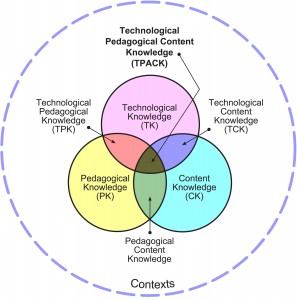The Information Technology department’s role in higher education, seen through the “TPACK” model

The TPACK model calls out three base areas of knowledge needed for effective technology-based teaching:
- Technology,
- Pedagogy, And
- Content Knowledge
Each of these areas is necessary for effective teaching:
- Technology: Understanding the tools themselves and what they can do, technically. Technology is everything from pencils to whiteboards to MS PowerPoint to Prezi to Learning Management Systems.
- Pedagogy: Pedagogy is knowing how to teach things. For example, if you want to teach about gravity, it could be helpful to show examples. Pedagogy is understanding when to lecture, use small groups, assign homework, or give tests–pedagogy is all about how to help people learn most effectively. “Instructional designers” are one kind of pedagogy expert.
- Content knowledge: Knowing the subject matter. Most University professors are hired for their content knowledge: biology professors understand the field of biology, for example.
The three TPACK areas are complementary, and you don’t need to know all three
People get into all kinds of trouble by assuming that if you know one of these areas, you have knowledge of the others. For example:
- It is assumed that professors have some pedagogical knowledge (i.e. they know how to teach). Most graduate programs, however, do NOT teach how to teach. Professors must go above and beyond to learn about pedagogy.
- IT people tend to think that because they know the technology, they understand how to teach effectively (pedagogy) using the technology. For example, because IT runs the Learning Management System they believe that all courses should use the Learning Management System. (However, having to ensure students understand and use a certain mandated tool may take away from time available for teaching.)
- Conversely, people who know pedagogy assume they understand the technology. For example, because (let’s say) the Learning Management System is an effective tool for assessing students, it should be rolled out to all applicants to test their foreign language proficiency. (However, the technology may not be designed for the added demand or accounts may not be provisioned before students are enrolled.)
It is fine–great, even–if you understand where you don’t have knowledge, and you work with others to fill in the gaps. You can quickly become overwhelmed if you try to be an expert at all three areas!
The role of Information Technology departments in the TPACK Model
I believe central Information Technology should have the technology knowledge, but that’s it.
IT should help people understand:
- Utility of the technology (i.e. what can be done–we can project HD video into classrooms)
- Warranty of the technology–the quality of service (e.g. how reliable is the service, how secure is it)
- Cost of the technology (both direct and indirect)
- Some of the risks associated with the technology
- Future of the technology–what’s the new stuff and what’s on it’s way out
The central IT department should NOT try to guess how this technology should support teaching (pedagogy): the Film department may need HD video, but so might the Biology department. Instead, there should be governance groups, partnerships, and campus experts in pedagogy who help match the technology to the classroom.
The role of IT specialists who directly serve faculty
However, as IT support gets closer to faculty (e.g. IT staff stationed in academic departments), IT support staff may need to know less about technology generally and more about pedagogy and content knowledge. For example, an IT support person in the Mathematics department needs to know how SPSS helps in the classroom vs. SAS. IT support for the Foreign Languages departments may need to understand Unicode character sets (technology) as well as when multiple character sets may be used alongside one another in the classroom (pedagogy) and whether currently obsolete but historical characters (content knowledge) are part of Unicode.
Takeaways
- Identify the pedagogy and content knowledge experts at your institution. Especially identify roles that require more than one set of knowledge, e.g. both pedagogy and technology knowledge.
- Understand people’s perceptions of the knowledge areas they possess and are expected to possess.
- IT departments should cultivate relationships with pedagogy experts and content knowledge experts.
- Academic IT governance groups need representation from all three knowledge areas: technology, pedagogy, and content knowledge.
- IT departments should endeavor to understand technologies and their future but NOT presume to know the technology’s value to teaching and learning.
- IT departments should be the expert in technology management (e.g. IT service management) and should be able to highlight the costs and risks of technology, which might not otherwise be obvious to pedagogy or content knowledge experts.
4 thoughts on “The Information Technology department’s role in higher education, seen through the “TPACK” model”
Comments are closed.